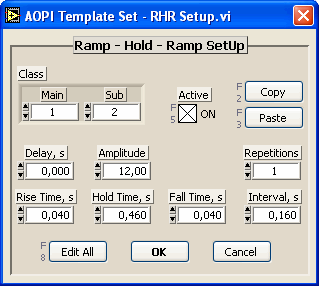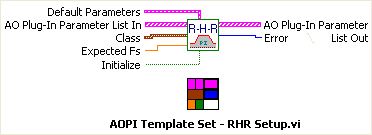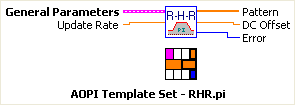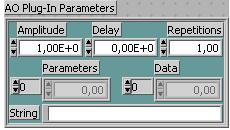|
The idea behind Analog Output Plug-Ins (AOPIs)
is to allow the user or programmer to extend the analog output capabilities
of Mr Kick without the need of updating the programme itself. This document
will give the background for developing AOPIs.
A plug-in is really a set of two VIs (LabVIEW Virtual Instruments), a
user-interface and a pattern generator. The two VIs share filename as
follows:
- User-interface: AOPIname Setup.vi
- Pattern Generator: AOPIname.pi
Where AOPIname is the name of the plug-in. Note the different
extensions, vi and pi. When you load an AOPI into Mr
Kick you can choose from the pi-files.
 The
related Setup.vi-file must exist in the same folder and will
be loaded automatically. The
related Setup.vi-file must exist in the same folder and will
be loaded automatically.
Both VIs can use sub-VIs (which must be available at load-time). All
VIs must be developed in the same version of LabVIEW as Mr Kick.
An example
AOPI is available here. This set of VIs will serve as illustration
in the following. It is equivalent to the Ramp-Hold-Ramp
plug-in.
 The
example also contains a VI that can be used to test AOPIs. The
example also contains a VI that can be used to test AOPIs.
>>> Under Construction <<<
VI Interface Pattern
The VIs are called dynamically from Mr Kick by use of the call by reference
method. They must comply with a specific interface pattern as descibed
below. Parameters and data types are explained later.
 The
user interface (vi) The
user interface (vi)
The user-interface VI is called when the user wants to change settings,
ie. prior to data acquisition. It has five inputs and two outputs.
 The
pattern generator (pi) The
pattern generator (pi)
The pattern generator VI is called during acquisiton, when Mr Kick prepares
to acquire a new sweep.
The generated pattern (maybe superimposed with another pattern) is output
on the analog output of the board; synchronized to acquisition of the
sweep.
The VI has two inputs and three outputs.
Parameters Explained
Sorry for the inconsistent naming ;-)
AO Plug-In Parameters
The AO Plug-In Parameter List In/Out, Default Parameters and General
Parameters are based on this set of parameters (settings) contained in
a single cluster.
The AO Plug-In Parameter Lists contain settings for each defined class
forming 2D arrays. Each element in addition contains a parameter, called
Active, indicating if the plug-in is to be applied in the given
class.
 The
settings contained in the AO Plug-In Parameters cluster (type defined): The
settings contained in the AO Plug-In Parameters cluster (type defined):
- Amplitude: Amplitude of the analog output pattern.
Scaling is applied by Mr Kick as specified under analog
output settings.
- Delay: Time in seconds from trigger to start of pattern
generation.
- Repetitions: The number of times the pattern should
be repeated.
- Parameters: A 1D array of SGL that can contain any
number of parameters of your choice.
- Data: A 1D array of SGL that can contain any number
of data points.
- String: A string that can be used for text or any
complex data-structure flattened to string.
Update Rate - and Expected Fs
Expected Fs is the update rate as set at the time when the user
edits the settings. Update Rate is the real update rate when
the pattern is applied.
Class
Rarely used...
Initialize
DC Offset
Error
Optional
Functionality
Each of the VIs must offer a minimum of functionality as explained hereafter.
The user-interface may offer additional services to the user.
The user interface (vi)
Settings can differ from class to class. They are contained in a 2D array
(list) - supplied to the VI when called, and the edited list is returned
by the VI. It is strongly recommended to include a Cancel-option. If the
user chooses to cancel editing the VI must return the original 2D array.
The pattern generator (pi)
Generates the pattern based on the General Parameters and actual
Update Rate. If the pattern requires a DC offset (in addition
to the offset specified by the user in the general
Analog Output settings), then it should be returned through the DC
Offset output and it will be applied to the analog output before
acquisition of a sweep.
|
